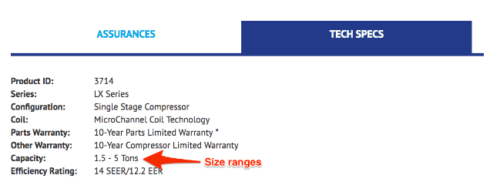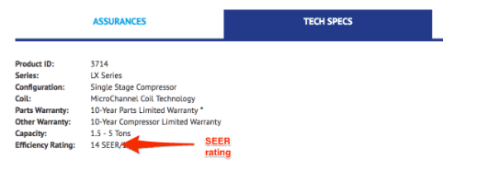What’s the Cost to Install a New AC Unit in Phoenix, AZ?
March 21, 2023
Are you in need of a new air conditioner this year? Whether your Phoenix HVAC unit is approaching 12 years old or it’s facing a major repair, it can feel overwhelming to think about all of the expenses involved with purchasing a new system. With central air conditioner prices spreading across a wide range, it’s hard not to feel discouraged—we get it and are here to help! Our guide shows you everything you need to know about buying a new AC unit in Arizona and covers potential savings opportunities.
Central Air Conditioner Prices Range from $6,500 to $22,500 per Unit
AC replacement costs range between $6,500 to $22,500. HVAC costs in Phoenix vary based on a few factors:
- AC unit’s size/capacity
- AC unit’s SEER (energy efficiency) rating
- Add-ons
- The contractor you hire
Most Phoenix HVAC companies, including Patrick Riley | Isley's, will provide a free estimate and include the cost of installation in your price.
HVAC Cost Factors
#1 - Size/Capacity of the Unit
When you’re looking for a new air conditioner, it’s important to know that, like your home, units aren’t “one size fits all.” Air conditioners come in different sizes or capacities, measured in tons. Tonnage refers to how much heat an AC unit can remove in a specific amount of time. For the most part, central air conditioner prices are related to the unit’s size.

Tech specs of a York central air conditioner Source: http://www.york.com/for-your-home/air-conditioners/air-conditioners-york-lx-series/ycs
Getting the Right Size is Important for These Reasons
- If the unit is too small, it will struggle to keep your home cool, especially on super hot days (or in Arizona, days ending in “y”).
- If the unit is too large, it will cool the home too quickly. This may seem like a good thing, but when this happens, the AC will prematurely shut off (a process known as “short cycling”). This short cycling increases HVAC costs in Phoenix, in addition to your unit wearing out faster and failing to do crucial tasks well — like dehumidifying.
How Do You Find the Right AC Unit Size?
Take the guesswork out of central air conditioner pricing and call your Patrick Riley Cooling experts today! Your home is unique, and so are your AC needs. A knowledgeable technician will visit your Phoenix home and perform a “Manual J Load Calculation,” which is a fancy way to determine the exact size of the unit you’ll need. Then they’ll provide an estimate of your AC unit cost in Arizona.
Keep these things in mind when talking with a representative regarding a new AC:
- Don’t allow a technician to recommend an AC for you without a home evaluation first. You may have a cooling system currently that is oversized or undersized! Getting the wrong system can increase HVAC costs significantly.
- Don’t allow a technician to determine your AC size based on a “rule of thumb,” such as going solely by the square footage of your home. There are other factors that they need to take into account, such as the temperature of the region and other variables that cause the home to gain heat.
- Get more information on the size of AC unit you need.
#2: SEER Rating

How much energy does your AC use? The Seasonal Energy Efficiency Ratio (SEER) will help you compare different AC units to evaluate their efficiency and cost to run them. The higher the SEER rating, the more energy efficient it is, and the more it costs at the time of purchase. However, a higher SEER-rated unit will run more efficiently, which will reduce your electric bills noticeably.
The minimum SEER rating for Phoenix homes is 14, and the maximum is 20+.
Not sure which SEER rating to choose? It can be confusing, so call Patrick Riley Cooling for help. We’ll answer all of your questions and explain everything so you can feel confident that you’re making the right choice!
#3: Add-ons
Ductwork Sealing
If your pre-existing ductwork is generations old, it can get leaky. When this happens, you can lose air to cracks and holes in your air ducts before it reaches the living space. Sealing the ductwork will ensure that your new, energy-efficient system actually works efficiently.
Programmable or Smart Thermostat
Modern thermostats can help you save even more by running the AC only as much as it needs to and during the times you program it to run. Families with smart thermostats can:
- Set schedules to cool down your home before exiting the hot car
- Set the thermostat and forget it, trusting that it will run on-time
- Manage their home’s heat or coolness from the comfort of their couch
Warranty Options
Contractors will usually provide various options for labor and manufacturer warranties:
- The manufacturer's warranty covers the cost of the part in case it breaks.
- The labor warranty covers the cost for the technician to replace that part.
Choose the warranty that works best for your situation. For example, If you’re going to move to another home within the next five years, you probably won’t want to splurge on an extended warranty.
#4: Contractor You Hire
Your labor cost will be a sizable portion of the final price of your AC unit cost. Unfortunately, it’s hard to tell who you should hire based on price alone (but definitely hire Patrick Riley Cooling and Heating!).
Here’s what to look for in a reliable HVAC contractor:
- Positive reviews — What are their ratings like on Yelp? Or the BBB?
- A physical location — You don’t want to hire a guy who works out of his van. Otherwise, he could install your system one day and disappear the next, making it hard to reach him if there’s an issue with your system.
- A thorough home evaluation — Did the contractor give you a price over the phone based on just your home’s square footage? Did they fail to do a Manual J Load Calculation? Stay away! Only hire someone who takes the time to understand your family’s unique cooling needs.
To evaluate contractors and central air conditioner pricing near you, start your search on Google Maps to review positive and negative reviews and get additional history about the company.
Are There Any Ways to Save with Patrick Riley Cooling & Heating?
With all of these variables considered, you’re probably wondering if there are ways we can help reduce furnace and AC replacement costs if you’re on a tight budget. The answer is yes! There are several ways you can avoid paying full price for a new unit up front.
- Flexible Financing — Patrick Riley Cooling, Heating, & Plumbing has partnered with several lenders in Arizona to offer flexible financing to customers. If you qualify for one of our select loans, you can manage the cost of your new AC unit over the course of several years. Log in every month and make payments at your leisure.
- Worry-Free Home Comfort — This simple long-term plan covers the cost of HVAC installation, repairs, and maintenance all at once. Sign up today for a YorkⓇ air conditioner and continue making low monthly payments over the next decade.
- Coupons — Check out our Coupons page from time to time to take advantage of other savings opportunities for your AC, heater, water tank, and more.
Installing New AC vs. Maintaining Old AC
The question in the back of every Arizona homeowner’s mind is “Can I still get by with an older AC to save money?” On one hand, a new AC is considered a major expense, and that’s often why customers look to repair rather than replace.
If an AC is over 12 years old, it will likely require frequent repairs and maintenance. Often, it will need part replacements to continue running. These problems will surface regularly for older units, making expenses pile up over time.
Get Help with Your AC System
Schedule a repair or get a central air conditioner price today! We know our way around all kinds of cooling machines. Homeowners in Phoenix, Mesa, Chandler, and surrounding Arizona cities trust the quality of our work, whether it’s furnace, HVAC, or plumbing repairs. Patrick Riley Cooling, Heating, & Plumbing has friendly technicians all across Maricopa County to ensure we repair your HVAC quickly and painlessly and that we do it to your complete satisfaction. We help alleviate the most anticipated problems that come with repairing the inside of an AC unit.
Get 10% off (Up to $150)

Ty Lindsay is the Director of Field Operations at Patrick Riley | Isley’s and a 15-year veteran of the plumbing and HVAC trades. In 2010, Ty earned his Journeyman’s plumbing license. He became a Master Plumber five years later and earned his Journeyman HVAC technician’s license that same year. Ty’s breadth of knowledge in plumbing and HVAC includes both residential and commercial work. He’s been a loyal member of the Patrick Riley | Isley’s team since 2016.
- Posted in:
